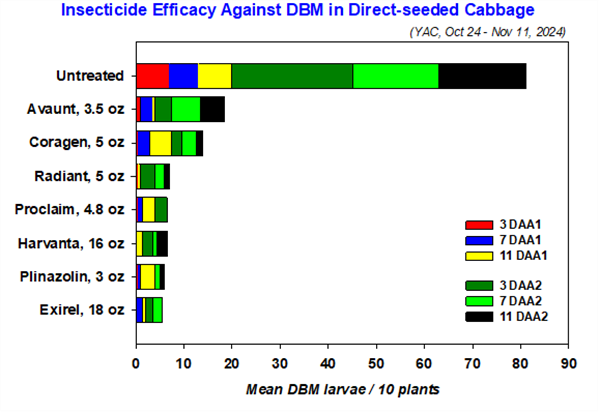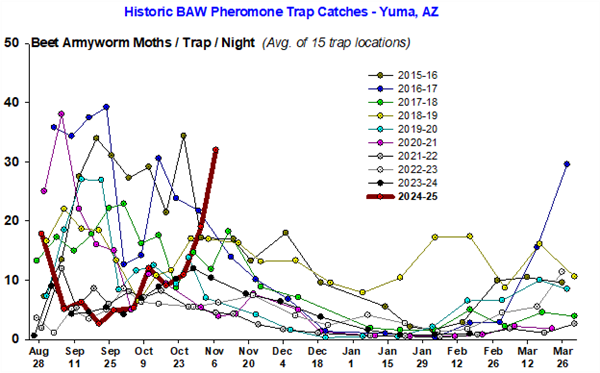Pest pressure in desert produce has begun to subside, but don’t become complacent. Although the local weather forecast calls for slightly below average temperatures for the next 10 days, conditions are still within the biological range of most of our fall pests. And it will soon become ideal for aphids. Below are some thoughts on the status of local pest pressure based on field sampling, trap counts and PCA reports.
Diamondback Moth (DBM): Reports of DBM on coastal transplants has quieted down a bit, but some PCAs have reported spraying more than usual for DBM on coastal transplants. So far, no reports of “uncontrollable” populations. Trials at the Yuma Ag Center are showing that standard insecticide products (Proclaim, Radiant, Exirel, Harvanta) are showing significant efficacy against DBM larvae as expected (see graph below). Of course, this is on direct-seeded cabbage and not coastal transplants. The weather should help slow down their growth and development but don’t become complacent. Populations still have the potential to get out of hand if not controlled properly, even in cooler weather. Beet Armyworm (BAW): BAW numbers are still above average in trials at YAC (1.0-1.2 larvae /plant) in untreated checks but have slowed a little. Furthermore, pheromone trap catches peaked last week and remain high areawide (see graph below). The cooler weather will slow them down, but expect light to moderate numbers for a while. Standard insecticides were effective in controlling BAW in efficacy trials at YAC this fall.
Cabbage looper (CL): CL numbers have been unusually light this fall and areawide trap catches have been historically low (see Areawide insect Trapping Network). Numbers have been significantly lower than normal in untreated plots at YAC this fall (<0.1-0.2 larvae / plant). But CL trap counts did increase in all areas last week, so keep an eye out for increased oviposition and hatches on your produce crops.
Western Flower Thrips (WFT): WFT started out strong in some locations in mid-October following winds and melon/alfalfa harvests, but have subsided considerably with cooler temps. Adult and larvae numbers are light in our insecticide efficacy trials at YAC. We did see a large population of Bean Thrips (BT) show up following the heavy winds out of the west in mid-October. Lannate and Radiant have been effectively controlling both WFT and BT in our trials. We have had our first report of INSV infected lettuce this fall, and as you can expect the infected plants were found on romaine transplants originating from the coast.
Aphids: Surprisingly, I’ve had several reports from PCAs throughout the area (Bard, Yuma Valley, Wellton and Dome) of small colonies showing up on lettuce and brassica crops. We’re also picking up small colonies at YAC. More than we typically see in Oct/Nov. Above average sticky trap catches have
shown a sharp increase in winged aphid movement in the past 3 weeks (see Areawide insect Trapping Network). This has coincided with windy conditions from the west-northwest. Most of the aphids I have seen colonizing have been green peach aphids. Weather has not been conducive for aphid population growth so far, but with the cooler temps coming you might expect to see more given the winged aphid movement we’ve been trapping. Historically, green peach aphid infestations are worse on spring
produce following above average monsoon and fall/winter rainfall. So far, it’s been pretty dry, and could be an indicator of things to come. Nevertheless, keep a close watch on aphids as we transition into our “normal” winter weather.







